And providing evidence of why some bird species “wear to dark”.
Some folks don’t pay much attention to Horned Larks but I always enjoy seeing them and I’ll photograph them at every opportunity. By nature I’ve always been what I call a “watcher” and for me that tendency had its roots as a kid growing up on the Montana family farm where the most common birds were Horned Larks and Western Meadowlarks.
I’d often hold still for long periods to see just how close birds would eventually approach me as they were foraging on the ground and those that came closest were usually Horned Larks (at the time I didn’t even know what they were called). As about a 7-year-old I remember noticing the erect horns and striking facial patterns of male Horned Larks for the first time when one came in very close and being fascinated by those subtle details I’d always missed at longer distances.
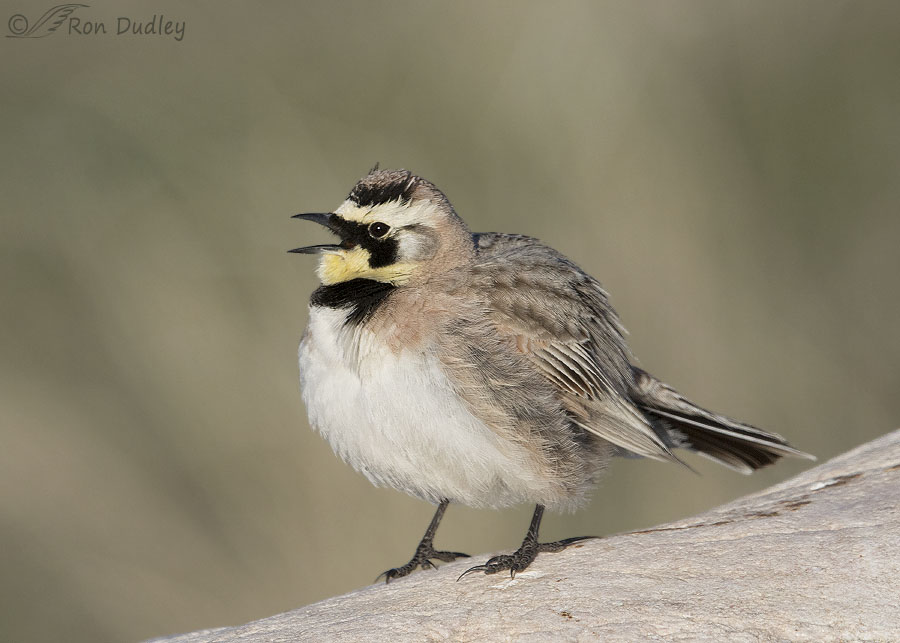
1/4000, f/7.1, ISO 640, Canon 7D Mark II, Canon EF 500mm f/4L IS II USM + EF 1.4 III Extender, not baited, set up or called in
So yesterday on Antelope Island I really enjoyed spending 6 full minutes with this male Horned Lark as he sang and preened on a rock in the morning sun. It was an unusually cold morning (it had been 23 degrees F. only a few minutes earlier) so the lark was fluffed up almost the entire time.
Compare the colors on the back and side of the bird in this photo to…
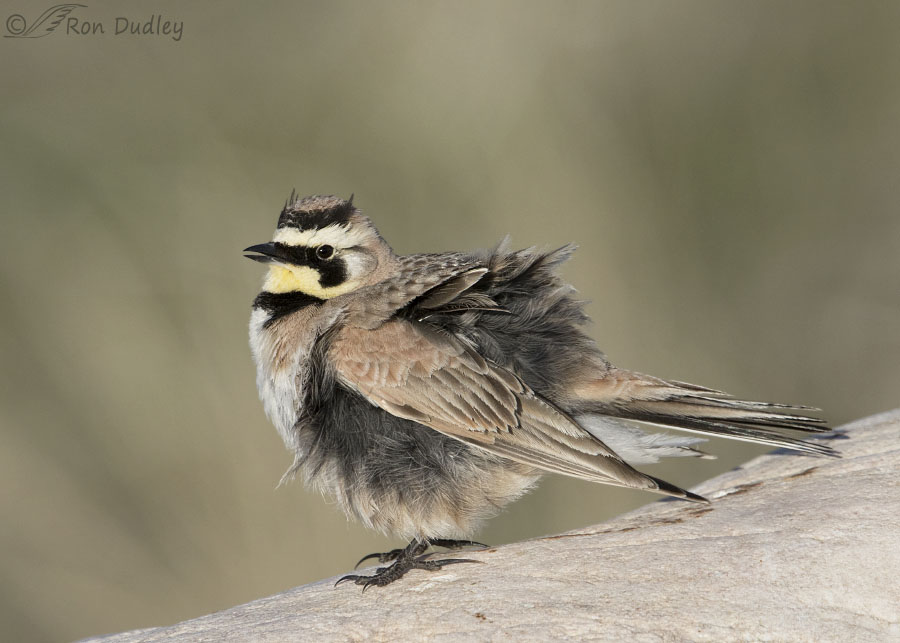
1/4000, f/7.1, ISO 640, Canon 7D Mark II, Canon EF 500mm f/4L IS II USM + EF 1.4 III Extender, not baited, set up or called in
those in the same bird in this shot and notice how dark those same feathers suddenly appear when they’re fluffed up. That’s because feathers overlap and we usually see only the colors of their terminal and lateral edges but the bases of those same feathers in many species are much darker than the parts we normally see. But when birds rouse or fluff up we often see those much darker feather bases.
That fact accounts for why many bird species “wear to dark”. As the lighter outside edges of those feathers wear away over time we begin to see more of the darker bases which alters the apparent color of the bird. I’ve noticed this process occurring especially in Chukars and Loggerhead Shrikes. I documented that color change in both species in this older post if you’re interested in seeing it.
Ok, back to the posing antics of this particular Horned Lark.
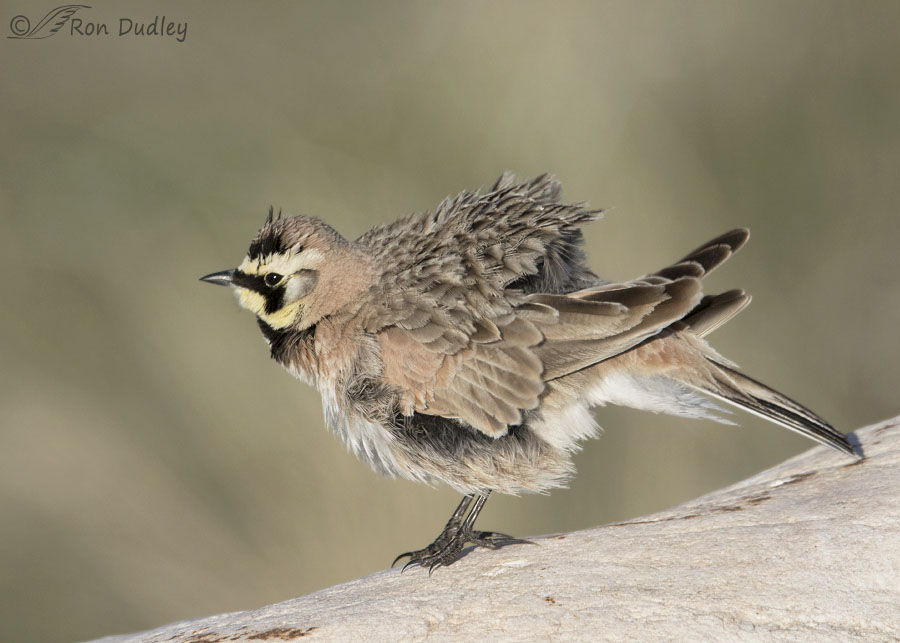
1/3200, f/7.1, ISO 640, Canon 7D Mark II, Canon EF 500mm f/4L IS II USM + EF 1.4 III Extender, not baited, set up or called in
When he roused some of his feathers were really tossed around, especially on his back.
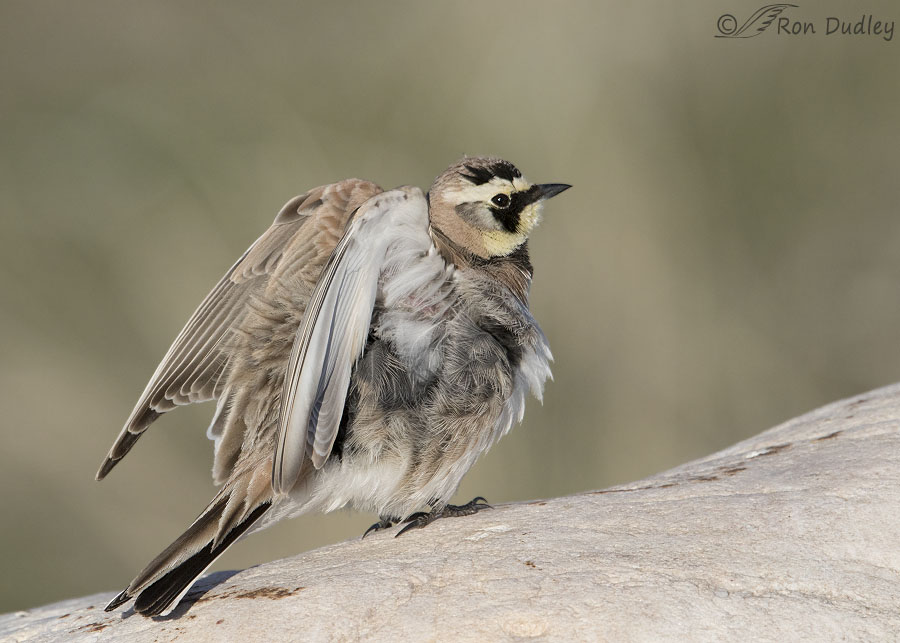
1/4000, f/7.1, ISO 640, Canon 7D Mark II, Canon EF 500mm f/4L IS II USM + EF 1.4 III Extender, not baited, set up or called in
Soon he performed a nice wing lift with eye contact and after he turned again on the rock he…
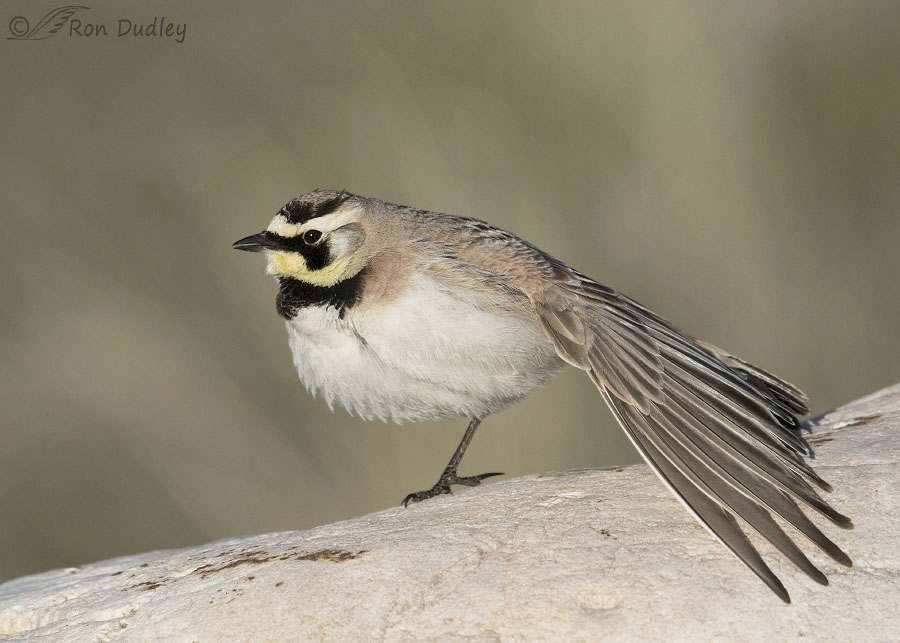
1/6400, f/7.1, ISO 640, Canon 7D Mark II, Canon EF 500mm f/4L IS II USM + EF 1.4 III Extender, not baited, set up or called in
performed a leisurely wing and tail stretch (here his tail is mostly hidden) with good eye contact again.
- Photographers may have noticed how my shutter speed skyrocketed for this shot when the very bright white belly and flank feathers were exposed to my camera sensor. That’s because I shoot in aperture priority so my SS changes depending on the brightness of my subject and/or setting.
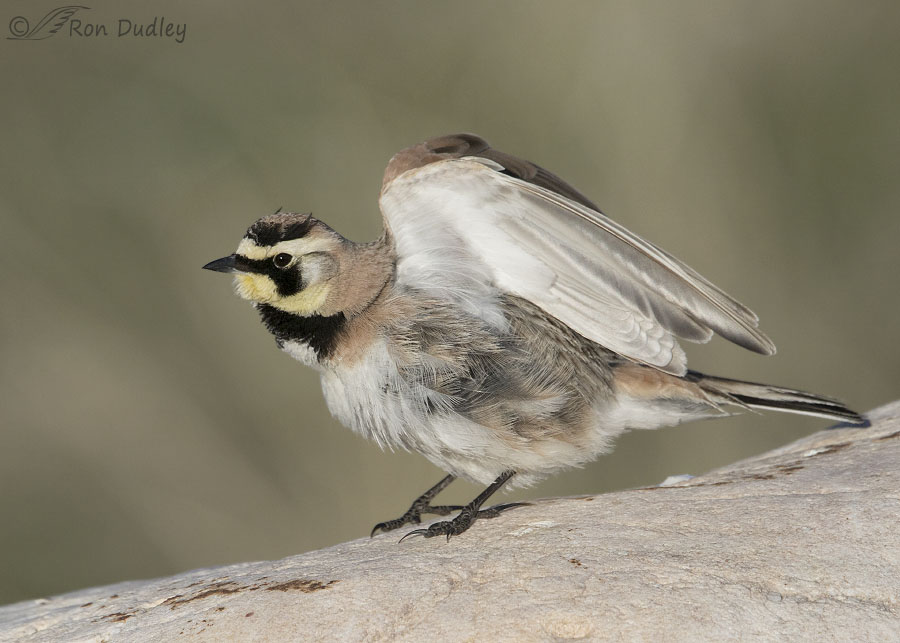
1/5000, f/7.1, ISO 640, Canon 7D Mark II, Canon EF 500mm f/4L IS II USM + EF 1.4 III Extender, not baited, set up or called in
He ended his extended performance with another wing stretch and then unexpectedly took off to my left. When he took off I cut off half of his body in flight because I was just too close for takeoff and flight shots. Par for the course for me…
I enjoy seeing good numbers of Horned Larks on the island again. They’ve been largely absent for much too long.
Ron


Great captures Ron, beautiful shots. We see a lot of Horned Larks during the winter along with Snow Buntings. Fun to watch!
We had (for us) some old die-hard migrants coming back on time or within a few days of past years, but for the next several days we’re in for serious wind and weather.
I wish we had a few of your Snow Buntings, Dick. I sure don’t see them very often.
Ron, love the photos and narrative, as well as you referring us to an older blog. The comments about the “wear to dark” are quite informative. I’ll try to observe them this Spring.
I love Laura’s story about the turkey vultures and playing dead. WOW she has quite a sense of adventure!!
Thank you, Ron.
Yes, she sure does. Thanks, Alice.
Yet ANOTHER stellar series. And hooray for discovering many, many more observers. And ponderers. And appreciators. I have discovered over the years that many (most?) people are not as interested in the appearance/behaviour of the other inhabitants of the planet as we are but my very adult self sticks her tongue out at them.
OK, let’s all stick out our tongues at the dull norms who cannot appreciate and wonder at the world around them–and those who are afraid of it, too!
(TONGUE STICKING OUT all the way) You idiots 😉
Ron I think he was showing off for you. Great sequence. Thanks Diana
Thanks, Diana. Maybe he was…
Do you always shoot aperture priority? And is that basically because you’re able to get so close with your lens that that’s the most important aspect of getting the shot? I have a consumer-grade camera (a D3200 with a 70-300mm) so it struggles to keep up with fast subjects, low light, stuff like that… I usually end up shooting in shutter priority because if I don’t prioritize shutter speed, any time a bird flies my photos are just a blur. 😀 I used to photograph mostly horses and I have to say, it was nice having a larger subject; with my equipment photographing birds is REALLY difficult. I guess it’s pushing me to be a better photographer, though, if only out of self-preservation. I don’t really want to have to sort through 300 images to find the one that came out kind of okay. ;D
Mac – yes, I always shoot in aperture priority, primarily for two reasons. I think whatever “system” you use the most important thing is to know it inside out, so you know its characteristics like muscle memory. I’ve used AP from the get-go and I don’t want to screw up a lot of shots trying to learn something else as well as I know AP or alternating between systems. Also, my lens is fast so I usually have enough SS to set it a little high and give me some wiggle room if I need it. Too much SS is better than too little…
A wonderful series…looks like that bird ran through it’s entire routine for you!!! Even let you see its underwear….
Yup, he showed me all his tricks, Patty. Including how to take off so fast I couldn’t keep all of him in frame.
Awesome series Ron!
Charlotte
Thanks, Charlotte.
You are not alone, Laura.
WOW! What a BEAUTY! I’ve only seen a few horned larks in my lifetime, but just WOW!
I’ve thought over the years that I was alone (perhaps crazy, too) for stopping in my tracks to watch bird/critter behavior!! It’s something I’ve always done, and when others are walking with me, I’m aghast that they don’t stop, too! I’m delighted to know I’m not alone!
But here’s the crazy part–one day I pretended I was dead just to draw in a vulture (or several) to land near me to check if I was ready to eat. It took about two hours, but one actually landed near me, curious to see if dinner was served, or not. S/he came within about 10 feet of me before s/he realized I wasn’t quite done. 🙂
And just so y’all know, I’m OK with being a crazy old hag. I’ve come to terms with it over the years, and being a geezer, I really don’t care what other folks think. That’s one of the big perks to being an old hag. Now I’ve told y’all the derivation of the term “old hag.” In ancient falconry language, the adult surviving raptors were called haggard and the term morphed over the millennia to mean an old female, similar to an old crone. I’m delighted to have reached old-hag status 😉
I’m right there wth ya, Laura! 🙂
I adored your vulture story, Laura!
Love that story – but am thinking of Monty Python ‘not dead yet’. I too am enjoying my cronedom.
HEHEHE! Loved Monty Python from the first time I saw it in England in 1970!!! There are so many sketches, among them, the parrot sketch. I laughed for days over that one! And, truth be told, it still makes me laugh. I’m so easily amused 😉
Anyway, the vulture expedition was a real hoot. I love vultures. They’re so curious and such characters.
Should I refill my bird feeder now (which will be twice in one day) or should I make them wait? Think flying pigs 🙂
What a neat little guy! I love seeing the horns. I’m so glad he spent some time with you and that you shared it with us.
My first thought was that he needed to get his “roots” done (sorry, it’s Snarknesday in our household). Then, of course, I start to ponder the benefits of wearing to dark or having a darker undercoat (underfeather?).
Interesting coincidence that all three of your examples wear a mask. 🙂
“I start to ponder the benefits of wearing to dark or having a darker undercoat (underfeather?)”
Here’s the way I understand it, Marty. Darker feather parts have more melanin in them than lighter colors and the melanin makes them stronger and more resistant to wear and to feather mites. So the smaller and lighter colored parts of the feathers that we normally see can do their job of providing proper breeding colors and camo but as those lighter parts wear away the darker and more resistant to wear parts are revealed.
Hope that makes at least some sense…
Love seeing this awesome bird. I’ve never seen one in person so they are an exotic species to me. Great photos once again!
Thank you, Joanne.
Thanks Ron for the great information along with the photos. Never seen a Horned Lark before but have many photos of the Loggerhead and now look forward to taking some this summer for comparisons…..I would’ve never known if you haven’t pointed this out. Thanks again.
That color change in shrikes can be very dramatic, James. They often look very dark and rough in late summer.
Beautiful photography Ron. I occasionally see Horned Larks here, but not often. Also much more elusive than the Western Meadowlarks. The Meadowlarks will pose for long periods of time whereas the Larks seem to jump around a lot more. Did you pretty much learn photography and cameras on your own or did you have a mentor or take instruction from professionals? Your work is outstanding.
Everett Sanborn, Prescott AZ
Thank you, Everett. When it comes to photography technique my most valuable resource was the years I spent posting photos to a nature photography critique forum (Nature Photographers Network) and getting critique from other photographers. Some NPN members were extremely generous in supplying information and advice about technique and even processing. My blog is an opportunity for me to give back and even pay it forward a little.
Love these photos and your narrative…always something new and interesting to learn with nature! Patience is indeed the name of the game with this bird!
You’re absolutely right, Kathy. I’m glad I have patience with birds because in other aspects of my life I’m sorely lacking in that quality…
Interesting! I’ve noticed the phenomena occasionally, but never thought much about it other than thinking the hot dusty weather and dust baths might have something to do with it. 🙂 Perfectly logical with wear and tear on the feathers….. Another great lesson on these creatures we often take for granted. 🙂
Thanks, Judy. You probably have many Horned Larks in your area (depending on habitat type of course) since you’re less than 100 miles south of our MT farm where they were extremely common in spring and summer.
I have seen them tho not “lots” – not looking either! 😉 Unless the ground is fallow they aren’t likely to be plentiful in the immediate vicinity…….
Yes, on the farm they were mostly found in summer fallow or stubble.